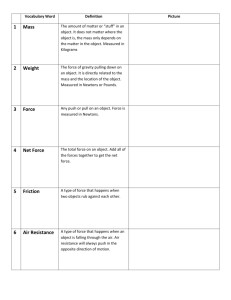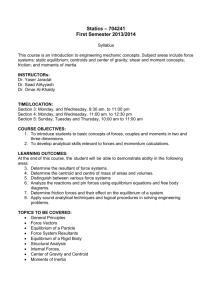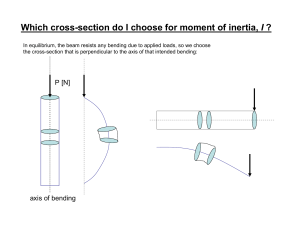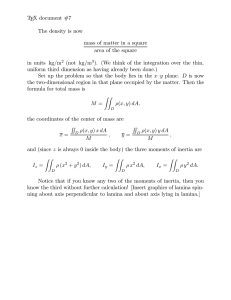CH. V ME256 STATICS Center of Gravity, Centroid,
advertisement
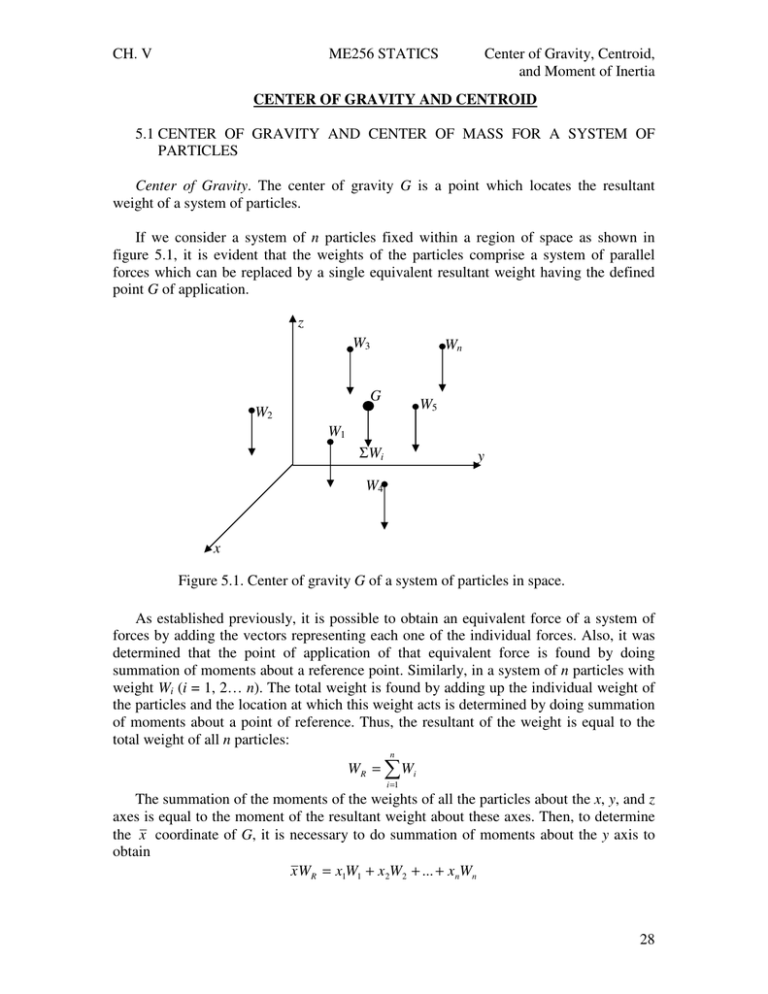
CH. V ME256 STATICS Center of Gravity, Centroid, and Moment of Inertia CENTER OF GRAVITY AND CENTROID 5.1 CENTER OF GRAVITY AND CENTER OF MASS FOR A SYSTEM OF PARTICLES Center of Gravity. The center of gravity G is a point which locates the resultant weight of a system of particles. If we consider a system of n particles fixed within a region of space as shown in figure 5.1, it is evident that the weights of the particles comprise a system of parallel forces which can be replaced by a single equivalent resultant weight having the defined point G of application. z W3 Wn G W5 W2 W1 ΣWi y W4 x Figure 5.1. Center of gravity G of a system of particles in space. As established previously, it is possible to obtain an equivalent force of a system of forces by adding the vectors representing each one of the individual forces. Also, it was determined that the point of application of that equivalent force is found by doing summation of moments about a reference point. Similarly, in a system of n particles with weight Wi (i = 1, 2… n). The total weight is found by adding up the individual weight of the particles and the location at which this weight acts is determined by doing summation of moments about a point of reference. Thus, the resultant of the weight is equal to the total weight of all n particles: n WR = ∑ Wi i =1 The summation of the moments of the weights of all the particles about the x, y, and z axes is equal to the moment of the resultant weight about these axes. Then, to determine the x coordinate of G, it is necessary to do summation of moments about the y axis to obtain x WR = x1W1 + x 2W2 + ... + x nWn 28 CH. V ME256 STATICS Center of Gravity, Centroid, and Moment of Inertia In a similar manner, to determine the y coordinate of G, calculation of summation of moments about the x axis is effectuated, yWR = y1W1 + y 2W2 + ... + y nWn The weights do not produce moment about z axis; therefore, the z coordinate of G is calculated by rotating the coordinate system, with the particles attached to it, by 90o about either the x or y axis, and then proceed in a similar manner as before z WR = z1W1 + z 2W2 + ... + z nWn Thus, following this procedure is possible to determine the coordinates of the center of gravity G of a system composed by n particles as n x= n n ∑ xiWi ∑ yiWi ∑zW i =1 n i =1 n i =1 n ; y= ∑W i ; z= ∑W i (5.1) ∑W i i =1 i i i =1 i =1 Center of Mass. The determination of the point known as center of mass is necessary to carry out the study of problems concerning to the motion of matter under the influence of a force. Provided that the acceleration due to the gravity g for every particle of the system is constant, then W = mg. In this way, Eq. (5.1) can be written as n ∑x m i x= n i =1 n ∑m ∑ym i i ; y= i =1 n ∑m i i =1 n ∑z m i i ; z= i =1 n ∑m i i =1 i (5.2) i i =1 5.2 CENTER OF GRAVITY, CENTER OF MASS, AND CENTROID FOR A BODY Center of Gravity. The determination of the center of gravity of a rigid body is accomplished by following the same principle discussed in the previous section. Since a rigid body is assumed to be continuous, it is possible to express every one of the coordinate of the center of gravity as x= ∫ xdW ; ∫ dW y= ∫ ydW ; ∫ dW z= ∫ zdW ∫ dW (5.3) To apply the above expressions is necessary to have a relation between the weight of the rigid body in consideration and its volume. If the density of the element studied is constant, Eq. (5.3) become 29 CH. V ME256 STATICS x= ∫ xρ gdV ; ∫ ρ gdV y= ∫ yρ gdV ; ∫ ρ gdV Center of Gravity, Centroid, and Moment of Inertia z= ∫ zρ gdV ∫ ρ gdV (5.4) In the above set of expressions g represents the acceleration of gravity (9.81 m/s2, 32.2 ft/s2). Center of Mass. The center of mass of a rigid body can be determined using the same principles employed to determine the center of gravity. Therefore, the center of mass of a body can be expressed as ∫ xρ dV ; y = ∫ yρ dV ; z = ∫ zρ dV x= (5.5) ρ dV ρ dV ρ dV ∫ ∫ ∫ Centroid. The centroid C is a point which defines the geometric center of an object. Its location can be determined using the same principles employed to determine the center of gravity of a body. In the case where the material composing a body is uniform or homogeneous, the density or specific weight will be constant throughout the body and these values will be factored out from the integrals [Eqs. (5.4) and (5.5)] simplifying the expressions for center of mass and center of gravity. In this specific case, the centers of mass, gravity and geometry coincide. Volume. When a body is subdivided into volume elements dV, as shown in figure 5.2, the location of the centroid C ( x , y , z ) for the volume of the object can be determined by computing the “moments” of the elements about each of the coordinate axes. x= ∫ x dV ∫ y dV ∫ z dV V V V ∫ dV V ; y= z ∫ dV V ; z= ∫ dV (5.6) V (x, y, z) dV (x, y, z) y x Figure 5.2. Calculation of the center of geometry in a volume. 30 CH. V ME256 STATICS Center of Gravity, Centroid, and Moment of Inertia Area. In a similar manner, the centroid for the surface area of an object (figure 5.3) can be determined by subdividing the area into differential elements of area dA and then calculating the “moments” of those infinitesimal areas about each axis of the coordinate system. y dA C(x, y, z) x z Figure 5.3. Calculation of the geometric center of an area. Application of the same principles used before to determine the center of gravity on a body yield the following expressions for geometric center of an area x= ∫ x dA ∫ y dA A A ∫ dA ; y= A ∫ dA ∫ z dA ; z= A A ∫ dA (5.7) A Line. Finally, if the geometry of the studied body is such as a thin rod or wire, it can be approached to a line. The balance of moments of the differential elements dL about each coordinate axis results in ∫ x dL x= L ∫ dL ∫ y dL ; L y= L ∫ dL L ∫ y dL ; z= L ∫ dL (5.8) L Homework No. 5.1: 9–4, 9–6, 9–9, 9–25, 9–38, 9–39. 31 CH. V ME256 STATICS Center of Gravity, Centroid, and Moment of Inertia z dL C(x, y, z) y x Figure 5.4. Calculation of the geometric center of a line segment. 5.3 COMPOSITE BODIES A composite body consists of a series of connected “simpler” shaped bodies, which may be rectangular, triangular, semicircular, etc. Such a body can often be sectioned or divided into its composite parts and if the weight and location of the center of gravity of each of these parts are known, it is possible to determine the center of gravity of the whole body from this information instead of carrying out the integration of the relevant equations. The procedure to find the center of gravity of a composite body requires treating each of the different “components” of the body as a particle, and then the application of the equations developed previously for finding the center of gravity of a set of individual particles. n x= n ∑ xiWi ∑ yiWi i =1 n i =1 n ; y= ∑W i i =1 ∑zW i ; z= ∑W i i =1 n i i =1 n ∑W i i =1 When the body has constant density or specific weight, the center of gravity coincides with the centroid of the body. The centroid for composite lines, areas, and volumes can be found using relations analogous to the equation presented previously. Homework No. 5.2: 9–45, 9–48, 9–60, 9–63, 9–75, 9–78. 5.4 RESULTANT OF A GENERAL DISTRIBUTED LOAD Pressure distribution on a surface. Consider the plate shown in figure 5.5. The plate is being subjected to the loading function P = P(x, y). Knowing this function it is possible to determine the force dF acting on the differential area dA. The magnitude of this force is dF = P(x, y) dA. The entire loading on the plate represents then a system of parallel forces infinite in number and each acting on a separate differential area dA. 32 CH. V z ME256 STATICS Center of Gravity, Centroid, and Moment of Inertia P = P(x, y, z) y FR z y (x, y, z) x x Figure 5.5. Determination of the resultant of a distributed load. Magnitude of the resultant force. The magnitude FR is determined by summing each of the differential forces dF acting on the entire surface area of the plate. FR = ∫ P( x, y )dA (5.9) A Location of the resultant force. The location of the centroid ( x , y ) of FR is calculated by setting the moments of FR equal to the moments of all the forces dF about the respective y– and x–axes ∫ xP( x, y ) dA x= A ∫ P( x, y)dA A ∫ yP( x, y) dA ; y= A ∫ P( x, y)dA (5.10) A The line of action of the resultant force passes through the geometric center or centroid of the volume under the distributed–loading diagram. Homework No. 5.3: Assignment problems will be provided by instructor. 5.5 REDUCTION OF A SIMPLE DISTRIBUTED LOADING In many situations a large surface area of a body may be subjected to distributed loadings such as those caused by fluids, wind, or weight of material supported by the surface of the body. The intensity of these loadings at each point on the surface is defined as pressure p (force per unit area). The unit for pressure is pascal (Pa = N/m2) or psi (pound per square inch). Also lb/ft2 is a unit frequently used to define pressure. The most common case of a distributed pressure loading is the uniform distributed loading. In this case, the loading is uniform along one axis of a flat rectangular body upon which the loading is acting. This case is shown schematically in figure 5.6. 33 CH. V ME256 STATICS Center of Gravity, Centroid, and Moment of Inertia p p = p(x) x Figure 5.6. Uniform loading on a plane surface. The direction of the intensity of the pressure load is indicated by the arrows shown on the load intensity diagram. The entire loading on the plate is a system of parallel forces, infinite in number and each acting on a separate differential area of the plate. In this case, the loading function, p = p(x), is only function of x since the pressure is uniform along the y axis. Since the loading is uniform along the y–direction, the diagram can be presented as w w(x) L x x Figure 5.7. Bidimensional representation of a uniform loading. Since the pressure exerted by the loading along y–axis is uniform, it is possible to represent the loading in terms of force per unit length by multiplying the pressure, p(x), by the width, a, of the plate. Thus, w(x) = a× p(x). This loading function shown in figure 5.7, is a measure of load along the plane of symmetry of the pressure load (line y = 0), and it is a measure of the force per unit length. Magnitude of the Resultant Force The calculation of the magnitude of the resultant force FR due to the distributed loading is obtained by adding up all the forces in the system. In this case, the number of forces is infinite and therefore the expression representing the load per unit length must integrated along the axis where the load is applied. FR = ∫ w( x)dx (5.11) L 34 CH. V ME256 STATICS Center of Gravity, Centroid, and Moment of Inertia As observed, the magnitude of the total force is equal to the total area under the loading diagram. Location of the Resultant Force The determination of the point at which the resultant force is applied can be found by doing summation of moments for the resultant force about a reference point and equating this expression to the summation of moments produced by each of the forces acting on the plate about the same point. That is FR X = ∫ xw( x)dx L ∫ xw( x)dx X = L FR (5.12) This equation represents the x–coordinate for the geometric center or the centroid of the area under the distributed loading diagram w(x). Therefore, the resultant force has a line of action which passes through the centroid C (geometric center) of the area defined by the distributed–loading diagram w(x). Homework No. 5.4: 4–142, 4–147, 4–153, 4–160. 5.6 DEFINITION OF MOMENTS OF INERTIA FOR AREAS In previous sections we learnt to determine the centroid for an area by calculating the first moment of the area about an axis; this is, we evaluated the integral of the form ∫ xdA A An integral of the second moment of an area, such as 2 ∫ x dA A is known as moment of inertia for the area. The moment of inertia of an area is a quantity that relates the normal stress σ or force per unit area, acting on the transverse cross section of an elastic beam to the applied external moment M, which causes the bending of the beam. The theory of mechanics of material shows that the stress within the beam varies linearly with the distance from an axis passing through the centroid C of the beam’s cross–sectional area (σ = kz), as shown in figure 5.8. The magnitude of the force acting on the area element dA is dF = kz dA. Since this force is located at a distance z from the y–axis, the moment of dF about the y– axis is dM = dFz = kz2dA. The resulting moment of the entire stress distribution is equal to the applied moment M. Then 35 CH. V ME256 STATICS Center of Gravity, Centroid, and Moment of Inertia M = k ∫ z 2 dA A This integral represents the moment of inertia of the area about the y–axis. This kind of integrals is commonly found in mechanics of materials, structural mechanics, fluid mechanics, and machine design. Moment of Inertia The moment of inertia about x–axis, for the differential planar area shown in figure 5.8, which lies in the x–y plane, is dI x = y 2 dA while the moment of inertia about y–axis for that differential element of area is dI y = x 2 dA y x dA r y x O Figure 5.8. Moment of inertia for an area on the x – y plane. Thus, the moments of inertia for the area are determined by I x = ∫ y 2 dA I y = ∫ x 2 dA A A (5.13) The moment of inertia about the “pole” O or z–axis is also known as polar moment of inertia. This moment of inertia is used to determine the torsional stress in a shaft. The polar moment of inertia is defined as dJ O = r 2 dA where r is the perpendicular distance from the pole to the element dA. Thus, the entire polar moment of inertia is J O = ∫ r 2 dA = I x + I y (5.14) A 5.7 PARALLEL – AXIS THEOREM FOR AN AREA If the moment of inertia for an area is known about an axis passing through its centroid, which is often the case, it is convenient to determine the moment of inertia of the area about a corresponding parallel axis using the parallel – axis theorem. 36 CH. V ME256 STATICS Center of Gravity, Centroid, and Moment of Inertia The moment of inertia about x–axis of the area shown in figure 5.9 can be expressed as I x = ∫ (dy + y ') dA = ∫ y ' 2 dA + 2d y ∫ y ' dA + d y2 ∫ dA 2 A A A A y’ y x’ dx dA y' C x’ dy d x O Figure 5.9. Determination of the moment of inertia of an area using the parallel – axis theorem. The first integral represents the moment of inertia about the centroid of the area. This integral is commonly known and presented in tables. The second integral is zero since ∫ y' dA = yA A and y = 0 since the arm of the moment is referred to the centroid of the area. Finally the last integral is the integral of the area. Therefore I x = I x + Ad y2 (5.15) I y = I y + Ad x2 (5.16) A similar analysis will lead to The polar moment of inertia about an axis perpendicular to the x–y plane and passing through the pole O (z–axis) J O = J C + Ad 2 (5.17) 5.8 RADIUS OF GYRATION OF AN AREA The radius of gyration of a planar area has units of length and is a quantity usually employed to designing columns in structural mechanics. If the moments of inertia are known, the radii of gyration are determined from the formulas kx = Ix A ky = Iy A kO = JO A (5.18) Homework No. 5.5: 10–5, 10–13, 10–19, 10–23. 37 CH. V ME256 STATICS Center of Gravity, Centroid, and Moment of Inertia 5.9 MOMENT OF INERTIA FOR COMPOSITE AREAS A composite area consists of a series if connected simpler parts or shapes. If the moment of inertia of each of these parts is known or can be determined about a common axis, then the moment of inertia of the composite area equals the algebraic summation of the moment of inertia of all its parts. Homework No. 5.6: 10–33, 10–37, 10–43, 10–46, 10–56. 38

